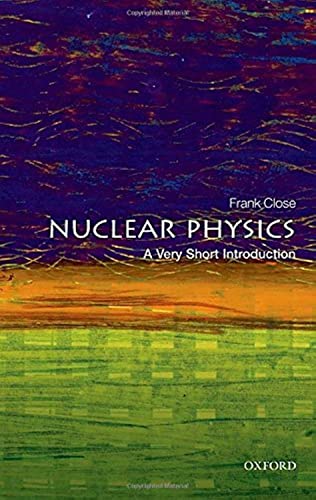Items related to Nuclear Physics: A Very Short Introduction (Very Short...

Synopsis
Nuclear physics began long before the identification of fundamental particles, with J. J. Thomson's discovery of the electron at the end of the 19th century, which implied the existence of a positive charge in the atom to make it neutral. In this Very Short Introduction Frank Close gives an account of how this area of physics has progressed, including the recognition of how heavy nuclei are built up in the cores of stars and in supernovae, the identification of quarks and gluons, and the development of quantum chromodynamics (QCD). Exploring key concepts such as the stability of different configurations of protons and neutrons in nuclei, Frank Close shows how nuclear physics brings the physics of the stars to Earth and provides us with important applications, particularly in medicine.
ABOUT THE SERIES:
The Very Short Introductions series from Oxford University Press contains hundreds of titles in almost every subject area. These pocket-sized books are the perfect way to get ahead in a new subject quickly. Our expert authors combine facts, analysis, perspective, new ideas, and enthusiasm to make interesting and challenging topics highly readable.
"synopsis" may belong to another edition of this title.
About the Author
Frank Close is Professor of Physics at Oxford University and a Fellow of Exeter College. He was formerly the Head of the Theoretical Physics Division at the Rutherford Appleton Laboratory, and Head of Communications and Public Education at CERN. He is the author of several books, including the best-selling Lucifer's Legacy (OUP, 2000), and was the winner of the Kelvin Medal of the Institute of Physics for his 'outstanding contributions to the public understanding of physics'. His other books include The Cosmic Onion (1983), The Particle Explosion (1987), End (1988), Too Hot to Handle (1991), and The Particle Odyssey (OUP, 2002). In 2013 Professor Close was awarded the Royal Society Michael Faraday Prize for Communication of Science.
"About this title" may belong to another edition of this title.
FREE shipping within U.S.A.
Destination, rates & speedsSearch results for Nuclear Physics: A Very Short Introduction (Very Short...
Nuclear Physics: A Very Short Introduction (Very Short Introductions)
Seller: BooksRun, Philadelphia, PA, U.S.A.
Paperback. Condition: Very Good. 1. It's a well-cared-for item that has seen limited use. The item may show minor signs of wear. All the text is legible, with all pages included. It may have slight markings and/or highlighting. Seller Inventory # 0198718632-8-1
Quantity: 1 available
Nuclear Physics: A Very Short Introduction (Very Short Introductions)
Seller: Goodwill of Colorado, COLORADO SPRINGS, CO, U.S.A.
Condition: good. This item is in overall good condition. Covers and dust jackets are intact but may have minor wear including slight curls or bends to corners as well as cosmetic blemishes including stickers. Pages are intact but may have minor highlighting writing. Binding is intact; however, spine may have slight wear overall. Digital codes may not be included and have not been tested to be redeemable and or active. Minor shelf wear overall. Please note that all items are donated goods and are in used condition. Orders shipped Monday through Friday! Your purchase helps put people to work and learn life skills to reach their full potential. Orders shipped Monday through Friday. Your purchase helps put people to work and learn life skills to reach their full potential. Thank you! Seller Inventory # 466h6j0003UH
Quantity: 1 available
Nuclear Physics: A Very Short Introduction
Seller: ThriftBooks-Atlanta, AUSTELL, GA, U.S.A.
Paperback. Condition: Fair. No Jacket. Readable copy. Pages may have considerable notes/highlighting. ~ ThriftBooks: Read More, Spend Less 0.29. Seller Inventory # G0198718632I5N00
Quantity: 1 available
Nuclear Physics: A Very Short Introduction (Very Short Introductions)
Seller: Goodwill Books, Hillsboro, OR, U.S.A.
Condition: good. Signs of wear and consistent use. Seller Inventory # 3IIT4Q0050US_ns
Quantity: 1 available
Nuclear Physics : A Very Short Introduction
Seller: GreatBookPrices, Columbia, MD, U.S.A.
Condition: New. Seller Inventory # 22766861-n
Quantity: 3 available
Nuclear Physics: A Very Short Introduction (Very Short Introductions)
Seller: Lakeside Books, Benton Harbor, MI, U.S.A.
Condition: New. Brand New! Not Overstocks or Low Quality Book Club Editions! Direct From the Publisher! We're not a giant, faceless warehouse organization! We're a small town bookstore that loves books and loves it's customers! Buy from Lakeside Books! Seller Inventory # OTF-S-9780198718635
Quantity: Over 20 available
Nuclear Physics : A Very Short Introduction
Seller: GreatBookPrices, Columbia, MD, U.S.A.
Condition: As New. Unread book in perfect condition. Seller Inventory # 22766861
Quantity: 3 available
Nuclear Physics
Seller: Books Puddle, New York, NY, U.S.A.
Condition: New. pp. 140 Index. Seller Inventory # 26371867782
Quantity: 1 available
Nuclear Physics: A Very Short Introduction Format: Paperback
Seller: INDOO, Avenel, NJ, U.S.A.
Condition: New. Brand New. Seller Inventory # 9780198718635
Quantity: Over 20 available
Nuclear Physics: A Very Short Introduction (Very Short Introductions)
Seller: California Books, Miami, FL, U.S.A.
Condition: New. Seller Inventory # I-9780198718635
Quantity: Over 20 available
